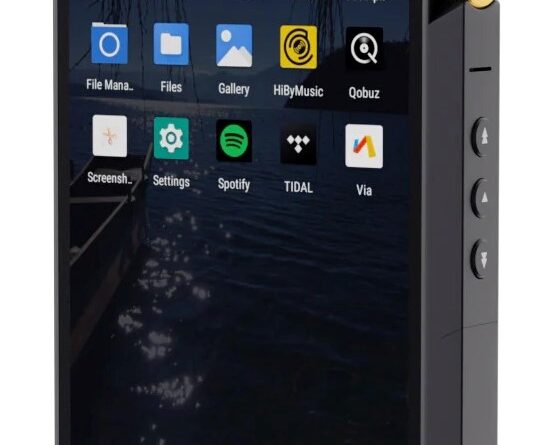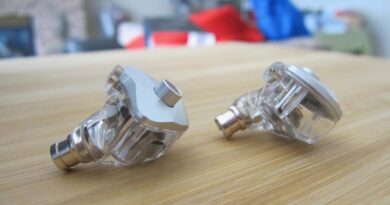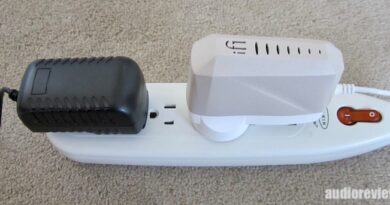Tempotec V6 Review (2) – Second Opinion
Following Jürgen’s recent review of Tempotec V6, the Dongguan-based manufacturer sent me a sample unit of their TOTL DAP to obtain a second opinion / review. I thank them for that.
As per our standard in such cases I’ll keep my piece a bit less descriptive as most of the general product information is already well covered by the original article. I’ll of course fill the pros&cons table, and I will add personal notes and considerations that might – hopefully – add something new to the reader’s benefit.
In this Article
At-a-glance Card
| PROs | CONs |
| Very good macrodynamics (imaging) and timbre | Limited resolving power, microdynamics and layering (in line with budget though) |
| Good output power | Underwhelming single ended output |
| Solid HiBy-developed system-level audio primitives | Limited output current |
| Choice of 6 reconstruction filters | Limited system performances |
| Choice of Low, High and Medium gain options | Stuck on Android 8.1 – no support for Roon ARC |
| Dedicated 3.5 and 4.4 Line Out ports | |
| Good battery life | |
| QC 3.0 quick charging support | |
| Good qualilty two-way BT 5.0 | |
| MQA full decoding |
What’s good for me
Sound
First a foremost, when judged vs its reference price V6 sounds good. Imaging (microdynamics) in particular is very nice. Extension is more than acceptable, and there is no significant sign of shoutyness or other “overdoings” from the 3KHz up. Well done.
The general device timbre, furthermore, is pleasant. It transmits a sense of silkyness – notes are well defined yet rounded. As a consequence V6 pairs best with bright / analythical drives.
On the flip side V6 is not the most resolving or microdynamical source you can get for the money – although quite likely the best one in form of a standalone DAP. On such regards it must honestly be kept in mind that miracles not being allowed, limited resources imply compromises. Cutting it with an hatchet, but not going far from reality, experience tells us that you “either” get good imaging with limited resolution, “or” a shaper accent on details but a fuzzier imaging, and fatigue on the midterm. Getting both at the same time requires different hardware (starting from the power module), therefore – by the way – higher budgets.
Power
V6’s balanced output delivers some very nice power, which turns into a lot of good flexibility. I find its almost 4V voltage swing OK for my HD600 in most if not all occasions, and 610mW on 32ohm are a great reservoir of power vs the overwhelming majority of IEMs out there, solely barred uncommon cases like Final E5000 or RHA CL2 – and fullsize hard planars, of course (more on this below).
Audio-specific system foundations
In exchange for being stuck with Andoid 8 (more on this below), V6 can adopt the full suite of audio-specific Android customisations originally developed by HiBy.
The most important of those is no doubt the bypass to Android’s stock audio driver, which “locks” all standard Android devices onto max 48KHz sample rate output – barred aposteriori interventions by clever apps e.g. UAPP, or, more recently, Roon ARC. On custom Android 8 there is a sort of “direct path” available between audio hardware and any higher-level apps, allowing the latter to fully exploit the former’s potential.
Another extremely interesting feature available at system level on these custom Android 8 distros is HiBy’s own user-friendly parametric EQ system called MSEB (as in “Magic Sound Eight Ball”)
The same feature is indeed included with HiBy’s music player app (“HiBy music”) – yet having it implemented down low at system level means you can exploit it also when using any other player app. Not a small thing at all.
MSEB has been developed to offer users a “friendly” way to tweak sound in very sophysticated ways, ideally obtaining similar results to what an EQ geek is able to, but without going through a steep learning curve hassle.
To use it the way it was conceived you need no guidance: just read the labels on the screen and drag the sliders left and right until you like the sound better.
For those who may be a tad more curious about what’s behind the hood, here is however some more technical notes coming directly from the developer 🙂
| Overall temperature | Imagine “tilting” the FR graph clockwise (warm, dark) or anticlockwise (cool, bright) |
| Bass extension | A low shelf filter cornered at 70 Hz with a critically selected Q factor |
| Bass texture | A bell filter cornered on 100 Hz, medium bandwidth |
| Note thickness | A bell filter cornered on 200 Hz, wide bandwidth |
| Voice | A bell filter cornered on 650 Hz, very wide bandwidth |
| Female overtones | A bell filter cornered on 3 Khz, tight bandwidth |
| Sibilance LF | A bell filter cornered on 5.8 KHz, medium bandwidth |
| Sibilance HF | A bell filter cornered on 9.2 Khz, medium bandwidth |
| Impulse response | A bell filter cornered on 7.5 Khz, very wide bandwidth |
| Air | A high shelf filter cornered at 10Khz and sloping up to 20Khz |
The various filter bandwidths are set such as to partially overlap one another’s tail when two adjacent ones are used together. Playing with them it is indeed possible to create some quite sophysticated schemes.
Other nice audio features
V6 offers full access to its DAC chips’ 6 (six!) different built in filters: Sharp Roll-off, Slow Roll-off, Short Delay Sharp Roll-off, Short Delay Slow Roll-off, Super Slow Roll-off and Low Dispersion Short Delay.
By the way: for an explanation of what reconstruction fiters are you may want to grab a coffee, then go read my article on the subject (I recommend: in the listed order…). Full AKM AK4493SEQ specs are instead available here, after some registration.
V6 has 4 (four) separate analog audio outputs: 3.5 and 4.4 headphone out, and 3.5 and 4.4 line out.
It’s worth noting that unlike other devices V6 does not offer S/PDIF (digital) coax output from its 3.5 jack port. To get S/PDIF out from V6 you need to pick it from the USB-C port, via an adapter.
While talking about digital ouputs (and inputs), V6 offers them both on Bluetooth and USB channels.
Bluetooth in particular is at level 5.0 and supports most advanced codecs including LDAP and APTX-HD. No APTX-LL however. BT in general is well implemented and I could get good connection stability both in and out on LDAP.
And good battery support
V6 carries a 4500mAh battery, which taken per se is one of those pieces of info that really mean nothing.
It becomes good news when we consider that
- The battery itself supports QC3 fast charging : with the right charger in just 1 hour you get up tp 70%
- The device consumption is quite modest. Based on my typical usage I could get more than 12-13h effective play time.
- Android’s deep sleep is correctly implemented: you can leave V6 “on, but sleeping” (like your phone) and it will last weeks
- Last but not least, 4000mAh are enough to cope with powering a not particularly hungry dongle (e.g. E1DA 9038SG3, Dragonfly Cobalt) in case you want to use one to sensibly upgrade V6’s internal sound quality
What’s not
Android
In spite of the audio-specific customisations – one above all: the proprietary patch allowing for bypassing of Android’s own audio drivers – Android still impacts negatively on sound quality.
How do you know? Just try. Take the very same track and play it once on the DAP, and another time from a good quality transport after connecting that DAP as an external USB DAC: the latter will transit through at a “lower” level, and will be audibly cleaner, airier, livelier. Do the same with a non-Android DAP and the differences, if any, will be much less evident.
That being said, Android brings a lot of additional convenience to a mobile audio player. Sure! So does the smartphone I already carry with me everywhere however. So why should I use carry dedicated mobile audio player (DAP) ?
Long story short the sole valid fundamental rationale is: because I want better sound quality. Correct.
Just be warned: a) on even price conditions you can and will find non-Android DAPs sounding significantly better than same-priced Android ones, so much so that b) there is no Android-based DAP seriously rivalling top sound quality DAPs (Questyle QPM, Lotoo Paw Gold Touch).
Android 8.1
Amonsgt the few really interesting possibilities opened by adopting Android (or iOS) is using the device as a mobile Roon terminal via the recently released Roon ARC app. Very true, very important. Too bad that Roon ARC requires Android 9 (or iOS 12) 🙁
Why is the overwhelming majority of the existing Android-based DAP still adopting Android 9 ? Quite simple if you think about it : no one wants (is able / can budget-justify) to develop new audio-specific kernel modifications. Everyone is forking / licensing the same original patches – hence they are stuck on that kernel version.
Limited system resources leading to limited system performances
As mentioned above, Android is supposed to bring flexibility as its main advantage. Key to that is the possibility to use multiple different applications to run different tasks, and do that concurrently, read: at the same time.
To reach such target a certain amount of system resources (computing power and RAM) are required. And that’s what V6 sadly falls short of. The Snapdragon 425 SOC is a 6 year old model – which is a loooong time span in the mobile gear CPU chips market. Furthermore, it’s equipped with just 2GB of RAM. By comparison my everything-but-TOTL Samsung A52 phone runs a 2020 SOC (Snapdragon 720G) on 8GB RAM.
Surely choosing an outdated SOC and very little RAM contributes keeping market price down – no question about it – however it also hampers applicative performances especially in terms of multitasking.
Long story short: V6 works OK when you launch one music player, and use it to its full extent (including some EQ etc), but it starts showing “fatigue” (slow UI responsiveness) or “serious fatigue” (sluggish UI, stuttering etc) when you keep more than one music player and/or other (e.g. messaging, video etc) apps up together.
Other (common) shortcomings
From some point of view V6 is a genuine son of its time – so I guess we should be mild on its main shortcomings as they are common to most if not all the rest of the market offering at the same prices, and sadly at higher prices too.
Much like most of its peers, V6’s Single ended output should be considered “there just in case you can’t but use it”. Sound quality with some meaning exclusively comes out the Balanced output line, really.
Additionally, while V6 is able to deliver some very significant output power onto high impedance (almost 4V swing on 300ohm) and mid impedance (610mW on 32ohm) loads, its architecture quickly drops the battleaxe as load goes down: current output vs sub-16ohm drivers is seriously limited, so much so that it does not pass the E5000 acid test. Again: V6 is in great company ! It would then be too severe to point this out as a shameful limitation or such. Just be warned that – as always – money matters, and “there ain’t such thing as a giant killer”(tm).
A couple of significant comparisons
Sony NW-A55
Simply put, NW-A55’s worst defect is that… it was recently discontinued. Until a year ago it was still on sale as new and, while already good in itself, thanks to a great humanity benefactor anyone could (and still can) even upgrade its internal operating system adopting more sophisticated versions Sony normally dedicates on their higher tier DAP models, turning A55 into a real sound quality masterpiece for a very modest budget (a bit less than 200€ retail).
A55 is worth mentioning as a part of our discussion today as it’s a glowing example of how a much lower priced device, free from the Android “burden” (see above), in terms of sound quality, audio features and UI/UX can closely rival a (good!) Android DAP like the V6 costing more than twice as much. Indeed in my opinion A55 still surpasses V6 in terms of sound definition and UI, while is succumbs as for sound extension, sheer output power, flexibility and compatibility.
HiBy R5
Also recently discontinued to be replaced by the much more expensive “R5 II Gen-2”, R5 was HiBy’s lower end Android-based DAP.
Lastly priced at the exact same ex works price as V6 ($369), the original R5 is extremely similar to its Tempotec competitor in terms of internal system hardware (same Snapdragon SOC, same system resources, same Android distro, same standard mods and apps), the meaningful differences consisting essentially in the audio section, whereon R5 is equipped by two CS43198 instead of V6’s more modern 2 x AK4493SEQ, complemented by 2 x ADP8397 opamps vs V6’s OPA1688.
R5 also has a smaller form factor (and screen), BT 4.2 instead of 5, and is minorly less powerful in terms of output wattage… details, really.
What’s most important: V6 sounds better. Not like day / night better, no, still very much audibly better. R5 sounds edgier, grainier, less refined.
Again, what matters to our discussion today is that the two devices are very similar under multiple design aspects, and they mainly differ insofar as V6 adopts a more modern DAC chipset. The existing although not excessive differences I find correspond quite exactly to my apriori expectation.
Wish I had a chance to audition HiBy’s latest R5 iteration, the R5 II GEN-2. I’m ready to bet it will be… very similar to V6 again – this time the gap being even smaller between the two, and it will be a close call wether one or the other can be called “better”.
Why do I reckon so ? Because R5 II is… pretty much again the same piece of base hardware (same Snapdragon SOC, same Android 8.1, same sw suite, same… etc), this time complemented with a more modern DAC chip set (2 x ESS9219C) and a Class-A output stage which will likely provide a tad better (cleaner, livelier) sound at the cost of a much higher power consumption.
How much difference will such more modern componentry make? Tough to say – as the burden represented by the antique (!) underlying hw and sw architecture will surely drain part of their good deeds…
Considerations and conclusions
Taking solely output audio quality in consideration the DAP market offers better quality for the dollar on proprietary-OS DAPs vs Android-based DAPs.
That said, for many adding more applicative flexibility to their pocket audio player device is a priority, and that’s where a general-purpose OS like Android comes into the equation.
Android DAP lovers don’t seem to really care about compromises in terms of sheer sound quality, or in terms of higher price budget, or both. Their (legit) mindset calls for Android-based DAPs to be considered (paraphrasing you-know-which movie line…) a separated ballpark, if even the same sport compared to custom OS ones.
All that recalled as a crucial preamble, as I tried to outline today Tempotec V6 clearly represents a solid staple in the sub-1K€ Android-based DAP panorama.
Its original introductory price of $280 made it into an absolute no brainer to be honest. At that price V6 was “the” budget Android DAP to own – full stop.
Now that the launch campaign is over V6 retails for $369 ex works, converting into a whiff less than €450 including EU VAT – which means stiffer competition, which however won’t likely significantly outrun V6 in terms of overall quality, leaving it as a still solid choice in its category and price segment.
Our generic standard disclaimer.







